Welcome back to Week 5 in my weekly report on what I’ve read recently on the Covid-19 pandemic and how I see some possible ways going forward. You can read the first report here, the second one here and the third here. Last week, I outlined 10 scenarios for colleges to potentially employ when it comes to the fall. Once again, we’ll be focusing on three major topics: a national view, higher education and study abroad.
There’s a lot of material to go through, so let’s get straight to it.
A national look
The great American experiment. As states continue to reopen, and cases in some continue to rise, it’s now all a question of how much risk is too much. New York provides an excellent example of a managed approach, with regional “control rooms” to monitor key metrics. So does Vermont.
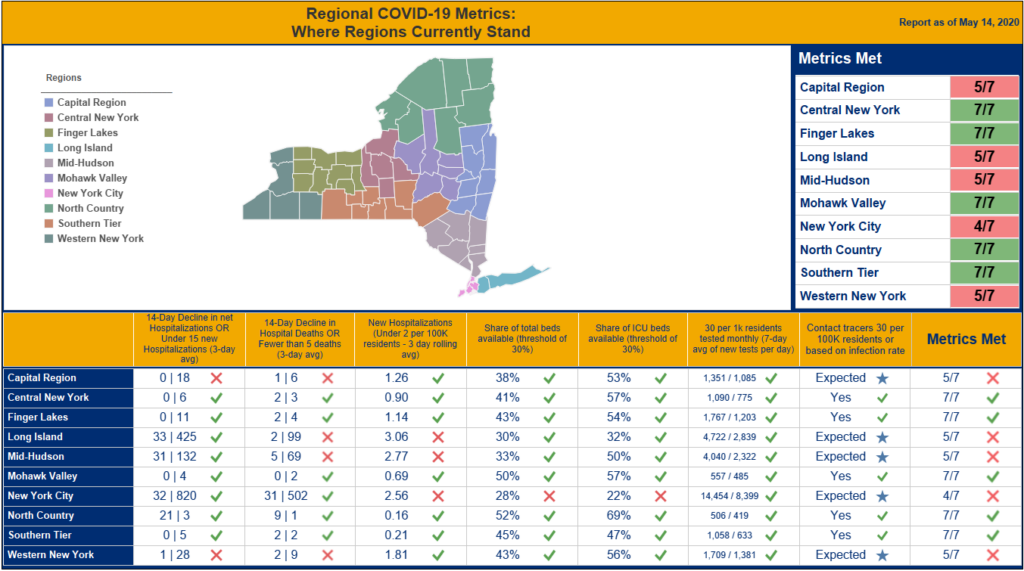
Let’s take a minute to analyze risk, with the hope that learning more about the risk of transmission can inform how we reopen. UMass Dartmouth biology professor Erin Bromage outlines some great points here. This graphic in the New York Times does a great job showing that places where people visit less frequently and for less time are safer. Masks have been shown to work. As the U.S. begins to wrestle with the fact that we will see 100,000 deaths by June 1, we must remain careful and not relax social distancing too quickly. However, as a whole, the nation is seeing a daily decline in cases and deaths.
Interesting new research shows that in China the vast majority of outbreaks occur in indoor settings. This makes sense. This CDC study from the state of Washington provides a compelling example. After one person with symptoms attended a choir practice, 87% of the choir developed Covid-19. Significant relaxation of social distancing restrictions (>50%) will result in catastrophic fatalities at this point, according to one model.
Let’s talk about numbers for a second. The graphic below shows the possible trajectory that case counts are reported from one infection. The delay from an infection to the realization of an increase in numbers could be a few weeks. We must keep that in mind as we continue to reopen. We still don’t have a complete picture of the outbreak and testing is critical. As a comparison, in the U.S., 7 tests yield 1 positive case, Taiwan — 150 tests and New Zealand — 180. Contact tracing is essential as well.
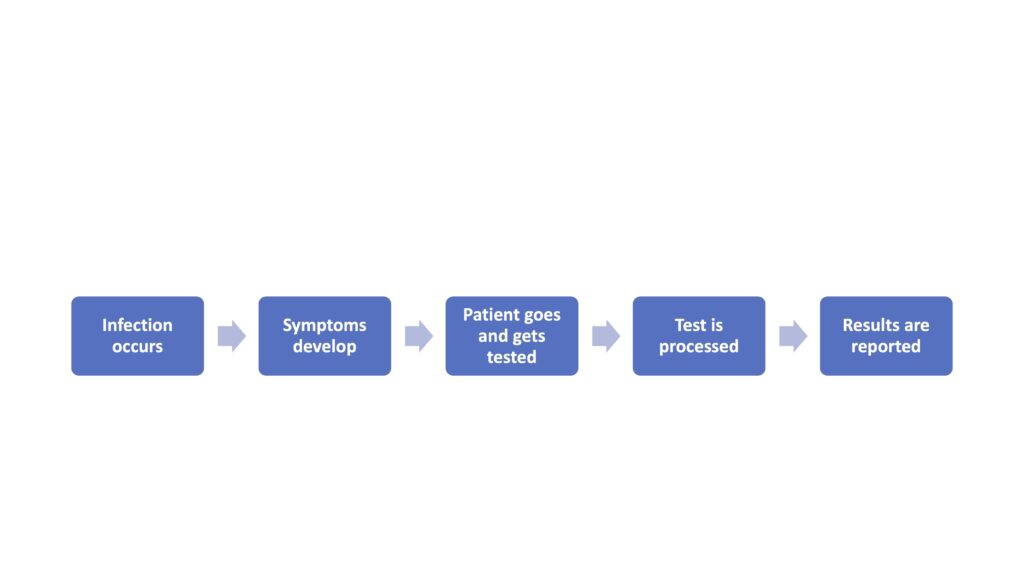
Transmission of this virus is dependent on three primary factors:
- Close contact
- Dense contact
- Prolonged contact
This week seemed like the longest week ever, based on what was happening at the White House and Capitol Hill. I’ll take a moment to highlight recent developments. “Our window of opportunity is closing,” ousted federal vaccine chief Dr. Rick Bright said in his testimony on Capitol Hill to the House Energy and Commerce Subcommittee on Health. There is no national plan. For anything. Our strategy has moved from containing the virus to harm reduction. The federal government has accepted the effects and has no clear plan moving forward. This virus is highly contagious, as this Japanese video shows. It is evident that this is not just a respiratory virus. There is a mysterious illness emerging in children that could be connected to the coronavirus. The Swedish model of herd immunity does not work. The Abbott rapid test, used in the White House, has a 48% false negative rate. A vaccine is nowhere near close (despite what President Trump says) and cutting corners could be fatal. Seroprevalence (antibody test) studies in Italy and Wuhan show only a small portion of people have been infected, demonstrating that the cost of herd immunity is far too great.
The CDC guidelines that were just released provided a watered-down version of those previously proposed. How are these traffic light decision trees supposed to help us open our economy? The Lancet, one of the country’s most renowned medical journals, took a stab at the agency early today. “Americans must put a president in the White House come January, 2021, who will understand that public health should not be guided by partisan politics,” the authors said.

There are places for hope. This article from Vox does a great job at outlining some of the steps we must take. It’s not rocket science.
2 areas for future consideration:
- What is the true effect of temperature and seasonality on the virus?
- How will people behave as the summer goes on?
Before we move on, I wanted to address this disturbing video by News 12 Long Island reporter Kevin Vesey covering a protest to reopen in Commack, New York. It was never a question of reopening or not reopening. It’s how you can do it in the safest way possible. “You’re the virus! Fake news is nonessential!” berated the protesters. This is unacceptable. Step it up, America.
With the fall on our mind, let’s move onto higher education.
Higher education
Cal State. You all know it. The nation’s largest public university system made the decision earlier this week to move the vast majority of their courses online for the fall. There are some interesting implications from this — it’s a large in-state population with the majority of students being upperclassmen. In the coming weeks, I will be working with other student journalists to evaluate college announcements using the following factors:
- Public/private
- Percentage of students on campus
- Percentage of students out of state
- Large/small
- Rural/urban
- Percentage of students on financial aid
There may be trends that emerge here. Three major universities in Canada — McGill University, the University of Ottawa and the University of Montreal — have announced similar online plans.
I’m will not present each school’s plans for the fall. That’s what this list from the Chronicle of Higher Education is for. I think we’ll see more changes in the weeks ahead.
64% of colleges in the Chronicle of Higher Education’s report have said that they will open for the fall and are planning for in-person instruction. This is down from 74% last week. Now, those could change, and many are waiting to see what form that will be. There are some reasons for announcing openings, as writer Jeff Selingo points out.
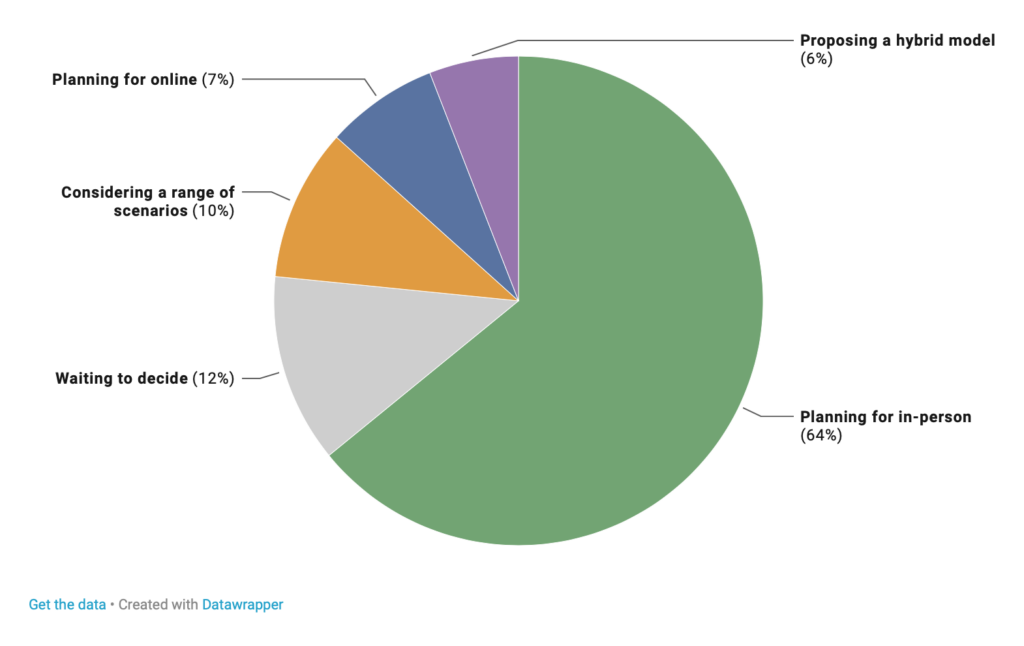
As campuses consider their options for the fall, some students and faculty fear going back to campus. Flexible curriculum models seem to be popular among students, as seen from this survey at Williams College.
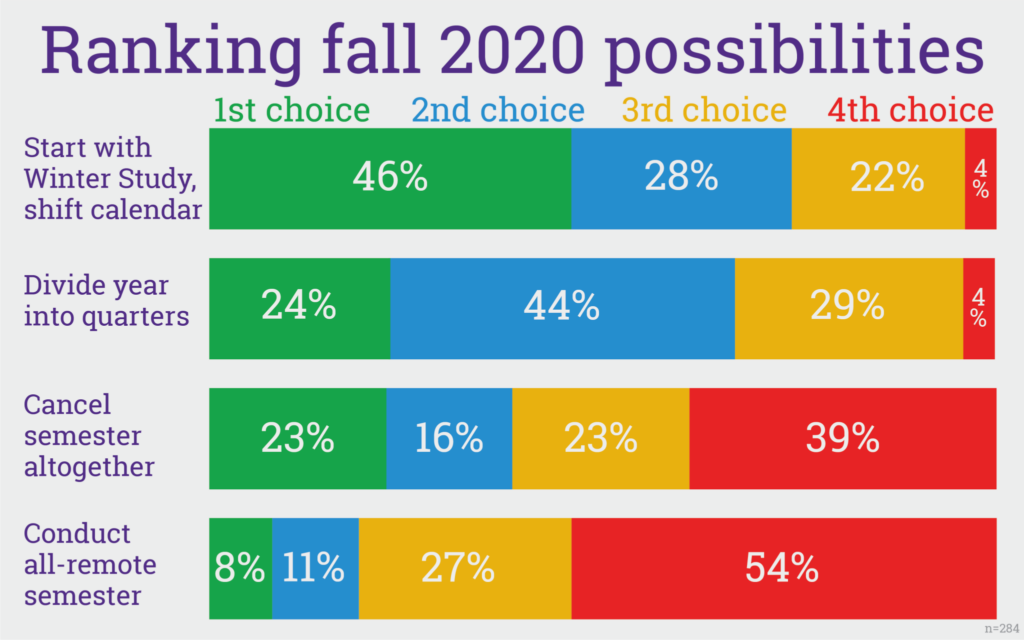
Procuring testing will be critical. This article from Tufts University shows how complex contact tracing can be — for one confirmed positive case in March, 140 contacts were traced. Fostering town-gown relations will be essential. Marquette University intends to start the semester in August and end before the beginning of flu season. In my opinion, this makes no sense. For those going online in the fall, this article points out some important aspects of the nonacademic experience: “If four-year colleges continue to find themselves shuttered in the fall, and they hope to keep many 18-year-olds as students, they’re going to have to figure out a way to meaningfully deliver (or at least enable) the extracurricular and social experiences that for many traditional students are why they enroll.”
The University of Kentucky has laid out some benefits and drawbacks of their plans, which I find intriguing.
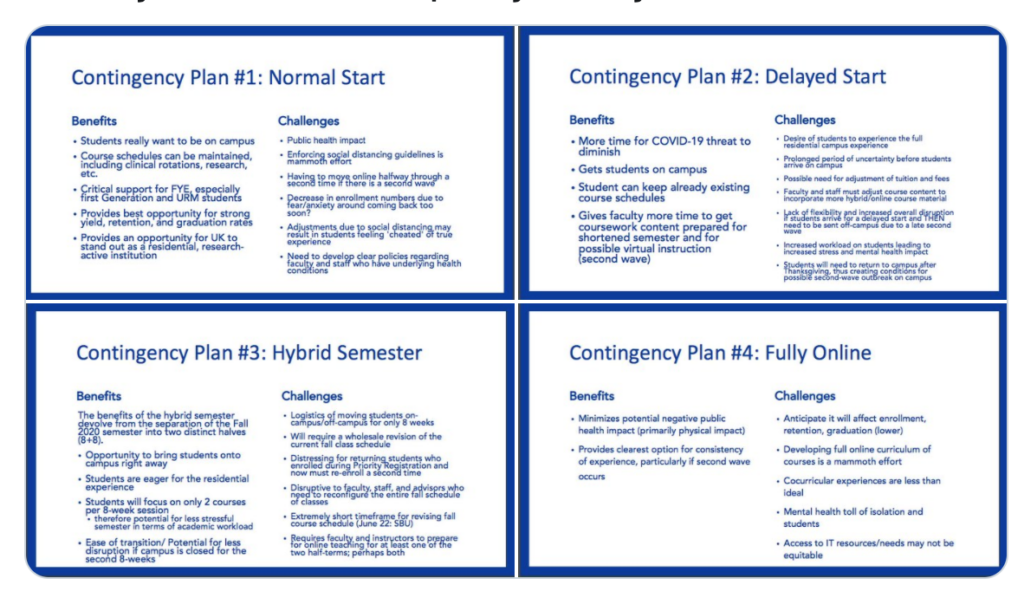
Vice President Mike Pence and Secretary of Education Betsy Devos held a call with education leaders to discuss possible solutions for the fall. However, as Sara Hebel and Andrea Klick point out, most of those on the call were from large research universities — only one from a liberal arts college and none from a community college. This is a gross misrepresentation of the higher education population in this country. Some colleges are seeking protection from lawsuits if they reopen.
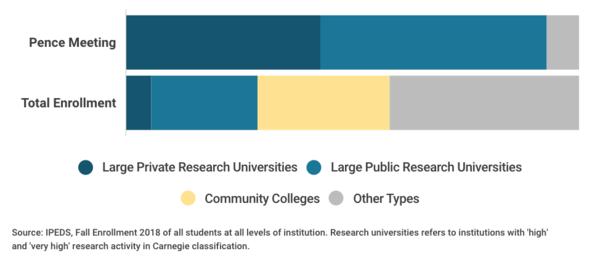
Finally, I wanted to introduce another scenario to the 10 I presented last week, pitched by Porter Hospital in Middlebury, VT ER doctor Mike Kiernan. This model, in our opinion, is best suited for small, possibly rural, colleges with low levels of current infection. Let’s call this the College Bubble model.
Everyone comes back to campus. There will be possible testing on arrival (assuming test capacity is up by then). For 2 weeks students all undergo quarantine in their dorms with social distancing and no gathering – meals are delivered. During this time, they will complete an online program, such as skill building, community building, leadership training or orientation (I suppose you could also do two weeks of online coursework). After 2 weeks, the school will test all students. If the test is positive, you quarantine the student(s) until 2 negative tests, per CDC guidelines. If the test is negative, they’re free to start the year with minimal social distancing requirements (Dr. Kiernan is an advocate of masks but no major measures for crowd control). “They’ll be free as an undergraduate,” he said. You can’t prevent students from going off campus to another city, but you instill in them that if you leave for a weekend trip to a big city, you can come back and quarantine for 2 weeks. They will be able to go into the local community due to its low infection presence. If there is an outbreak, you test, trace, treat. While contact tracing is hard, it’s possible.
Now that I’ve introduced the theory, let’s take a look at some frequently asked questions.
- Can you heavily enforce not leaving or congregating during the two-week period? Probably not. But I believe that if you tell students that after two weeks, they’ll be able to live a close to normal semester, I think you would have high buy-in.
- Athletics? No solution currently. “It’s an unwise risk,” Dr. Kiernan said.
What’s the idea behind this model? This is your chance to “cleanse” the campus and practice infection control as best you can. Once the population is “set free,” there is a low risk of infection. There is still a risk — don’t get me wrong. But this is an opportunity to control for the virus and have some sort of purposeful, intentional experiential learning curriculum. By the start of the semester, you’ve done the best you can in this challenge.
I’d be curious to hear your thoughts on this model in the comments section. In my opinion, it is guided by risk management principles and shows promise. It does present the need for high levels of community trust.
Study abroad and international travel
Not much to report on this front. Three main updates.
- As my colleague Colleen Cronin reports in the Brown Daily Herald, Brown University has cancelled all abroad programs for the fall. I expect more to follow.
- A new survey from the Institute of International Education (IIE) shows that 88% of respondent institutions anticipate that international student enrollment will decrease in the 2020/21 academic year.
- Another survey from IIE shows that 9 out of 10 international students at the colleges surveyed did not return to their home countries after COVID-19 closed campuses. That’s right — 92% of current students are still in the U.S.
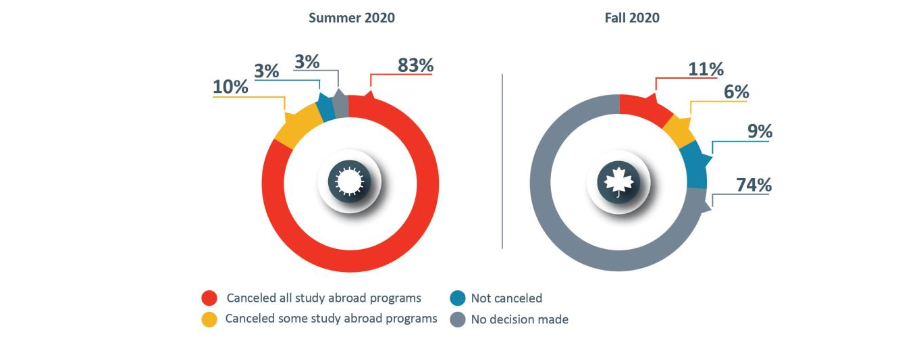
The Good Stuff
Lots of hard news this week. Let’s roll the clips of the good stuff. In my weekly tradition, I feature my favorite pieces from the week.
- New York City hospitals break out into song discharging coronavirus patients.
- Administrators (and their dogs) are keeping the University of Iowa running. Congratulations on a great tenure, Marissa!
- New York Governor Andrew Cuomo’s sign language interpreter is actually pretty interesting.
- Dogs join a Zoom meeting.
- Teenagers in relationships learn to live with separation.
- The Vermont National Guard delivers 55,000 meals to 1,900 cars in one day.
- Tufts newspaper guru Elie Levine celebrates her 22nd birthday. Happy birthday, Elie!
- Student journalists at Washington University in St. Louis pay tribute to the Class of 2020.
- A 92-year-old piano teacher continues to deliver piano lessons over Zoom.
- A dad builds a stage in his driveway to host a college graduation for his daughter.
- A 108-year-old New Jersey resident, who lived through the Spanish Flu, also recovered from Covid-19.
Conclusion
We continue to persevere with our country’s fight against the pandemic and its effects on higher ed. The news cycle continues to move exceptionally fast. We can’t let up now, especially with warmer weather and increased mobility. There is hope.
I’d like to thank all the student journalists with whom I have the pleasure of working. You are all truly an inspiration and I so enjoy reading your work.
Let’s all keep doing what we’re doing and we’ll get through this together. My best to all for good health.
Like what you see? Don’t like what you see? Want to see more of something? Want to see less of something? Let me know in the comments.
For more instant updates, follow me on Twitter @bhrenton.
Featured image: Congrats to the bird in my gutter on the birth on her two babies!

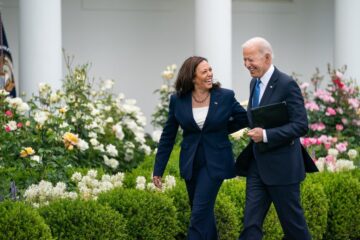
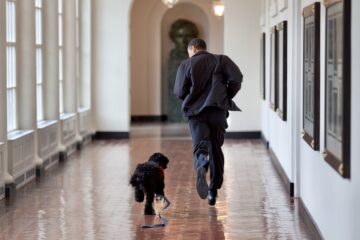
1 Comment
Where We Stand with Covid-19 — June 5 - Off the Silk Road · June 6, 2020 at 12:44 pm
[…] to college students. All new recruits arriving to the base were put in a two-week quarantine (similar to my College Bubble model). In a population of 10,579 trainees, Covid-19 incidence was limited to five cases (47 per 100,000 […]
Comments are closed.